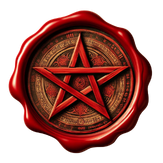Abracadabra is a very common ancient triangular amulet against disease. It was engraved on amulets with the following arrangement:
A B R A C A D A B R A
A B R A C A D A B R
A B R A C A D A B
A B R A C A D A
A B R A C A D
A B R A C A
A B R A C
A B R A
A B R
A B
A
But, what does it mean?
1st explanation:
According to Kabbalists, its root is the Holy Trinity in Hebrew, namely: Ab (Father) - Ben (Son) - Ruach Acadsch (Holy Spirit).
2nd explanation:
From the Aramaic "Avrah KaDabra" meaning "I create as I speak", an expression very similar to the Hebrew "Aberah KeDaber" which has the same meaning.
3rd explanation:
From the first 4 letters of the Phoenician alphabet: A Bra Ca Dabra, which are apparently not far from the first 4 Latin letters A B C D. But in this possibility, it’s not clear why the first 4 letters of an alphabet have power against diseases.
4th explanation:
The name of the Latin deity Abrasax, who in Jewish mythology he is found as the demon Abraxas, who has the head of a king and his feet are snakes. He is often depicted wearing a crown and holding a whip. The belief that it is a demon was also later adopted by Christians, associating it with the Beast of the Apocalypse, which will be destroyed on the Day of Judgment.
But, there is also the Egyptian Abraxas, God of Time, and "Abraxas" as one of the names of God, according to the claims of the Gnostics. This arises through Greek numerology: if the letters of the name Abraxas are added according to the Greek "Αβρασαξ", they give a result of 365 = the number of days in the year. In addition, Abrasax was worshiped by some Gnostic movements as a God who united Jehovah and Mithra. Given that Mithra's sum is also 365.
5th explanation:
Φrom the Arabic "Abra Kadabra" meaning "may these be destroyed" (probably referring to diseases), reminiscent of another Aramaic expression, "abhadda kedhabhra" meaning "disappear like this word", which, at least logically, it also has a schematic agreement with the amulet, since it is written in such a way that the word slowly disappears.
6th explanation:
From the name of a Syrian God Abracalan.
History
The first mention of this amulet is by the physician of the Roman Emperor Caracalla, Serenus Sammonicus, in the 2nd century AD, in his manuscript 'De Medicina Praecepta'. Sammonicus writes that the amulet in question should be worn on the patient in order to exorcise the demon possessing him. It describes exactly how it is written in a triangle, on paper which is then folded to form a cross and worn for 9 days around the neck. On the 9th day before sunrise, it is thrown into a stream that has a westerly direction, so that the demon afflicting the patient will leave with it. However, it is not mentioned where Sammonicus received this knowledge, forcing us to assume that it is probably a popular tradition.
Later Roman Emperors such as Geta and Severus, embraced the medical methods and teachings of Sammonicus, using (among other things) the triangular amulet Abracadabra under his instructions.
Other accounts speak of the Alexandrian Gnostics, the Basilians, who used the word as one of the occult names of God, creating a talisman, usually made of precious stones, with the word carved on it in a pyramidal arrangement, believing it protected against various diseases. The Gnostics in Rome also used the same amulet, believing it to attract benevolent spirits that protected the wearer from serious and incurable diseases.
How to use it
The Abracadabra is written on paper or linen cloth or engraved on metal or precious stone, always in the triangular arrangement mentioned above, and worn around the neck to protect the wearer from ailments and/or rid them of those they already have.
Sometimes, the word is used and recited during incantations or rituals, with the aim of exorcising diseases or invoking good health. It is recited either in its entirety repeatedly, or its triangular arrangement, by removing one letter from the end each time.
So, there! Now you know everything there is to know about ABRACADABRA!


Comments ()